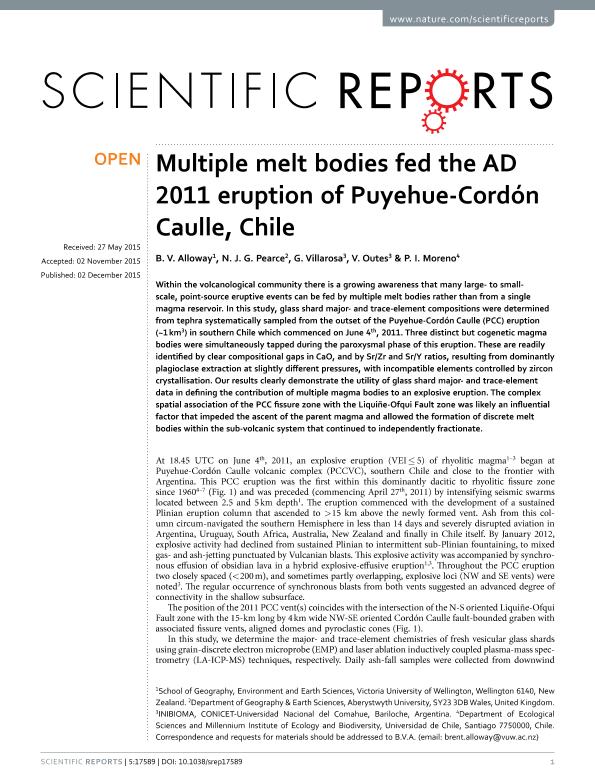Mostrar el registro sencillo del ítem
dc.contributor.author
Alloway, B. V.
dc.contributor.author
Pearce, N. J. G.
dc.contributor.author
Villarosa, Gustavo

dc.contributor.author
Outes, Ana Valeria

dc.contributor.author
Moreno, P. I.
dc.date.available
2017-01-26T19:28:37Z
dc.date.issued
2015-12
dc.identifier.citation
Alloway, B. V.; Pearce, N. J. G.; Villarosa, Gustavo; Outes, Ana Valeria; Moreno, P. I.; Multiple melt bodies fed the AD 2011 eruption of Puyehue-Cordón Caulle, Chile; Nature Publishing Group; Nature Scientific Reports; 5; 17589; 12-2015; 1-8
dc.identifier.issn
2045-2322
dc.identifier.uri
http://hdl.handle.net/11336/11999
dc.description.abstract
Within the volcanological community there is a growing awareness that many large- to small-scale, point-source eruptive events can be fed by multiple melt bodies rather than from a single magma reservoir. In this study, glass shard major- and trace-element compositions were determined from tephra systematically sampled from the outset of the Puyehue-Cordón Caulle (PCC) eruption (~1 km3) in southern Chile which commenced on June 4th, 2011. Three distinct but cogenetic magma bodies were simultaneously tapped during the paroxysmal phase of this eruption. These are readily identified by clear compositional gaps in CaO, and by Sr/Zr and Sr/Y ratios, resulting from dominantly plagioclase extraction at slightly different pressures, with incompatible elements controlled by zircon crystallisation. Our results clearly demonstrate the utility of glass shard major- and trace-element data in defining the contribution of multiple magma bodies to an explosive eruption. The complex spatial association of the PCC fissure zone with the Liquiñe-Ofqui Fault zone was likely an influential factor that impeded the ascent of the parent magma and allowed the formation of discrete melt bodies within the sub-volcanic system that continued to independently fractionate.
dc.format
application/pdf
dc.language.iso
eng
dc.publisher
Nature Publishing Group
dc.rights
info:eu-repo/semantics/openAccess
dc.rights.uri
https://creativecommons.org/licenses/by-nc-sa/2.5/ar/
dc.subject
Cordon Caulle
dc.subject
Volcanic Eruption
dc.subject
Magma Chambers
dc.subject
Magma Geochemistry
dc.subject.classification
Vulcanología

dc.subject.classification
Ciencias de la Tierra y relacionadas con el Medio Ambiente

dc.subject.classification
CIENCIAS NATURALES Y EXACTAS

dc.title
Multiple melt bodies fed the AD 2011 eruption of Puyehue-Cordón Caulle, Chile
dc.type
info:eu-repo/semantics/article
dc.type
info:ar-repo/semantics/artículo
dc.type
info:eu-repo/semantics/publishedVersion
dc.date.updated
2016-12-12T14:30:58Z
dc.journal.volume
5
dc.journal.number
17589
dc.journal.pagination
1-8
dc.journal.pais
Estados Unidos

dc.description.fil
Fil: Alloway, B. V.. University of Wellington; Nueva Zelanda
dc.description.fil
Fil: Pearce, N. J. G.. Aberystwyth University; Reino Unido
dc.description.fil
Fil: Villarosa, Gustavo. Consejo Nacional de Investigaciones Científicas y Técnicas. Centro Científico Tecnológico Patagonia Norte. Instituto de Investigación en Biodiversidad y Medioambiente; Argentina. Universidad Nacional del Comahue; Argentina
dc.description.fil
Fil: Outes, Ana Valeria. Consejo Nacional de Investigaciones Científicas y Técnicas. Centro Científico Tecnológico Patagonia Norte. Instituto de Investigación en Biodiversidad y Medioambiente; Argentina. Universidad Nacional del Comahue; Argentina
dc.description.fil
Fil: Moreno, P. I.. Universidad de Chile; Chile
dc.journal.title
Nature Scientific Reports
dc.relation.alternativeid
info:eu-repo/semantics/altIdentifier/url/http://www.nature.com/articles/srep17589
dc.relation.alternativeid
info:eu-repo/semantics/altIdentifier/doi/http://dx.doi.org/10.1038/srep17589
Archivos asociados
